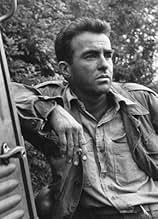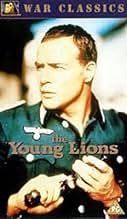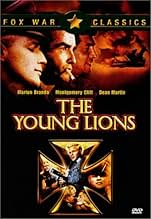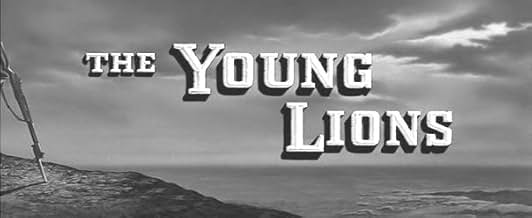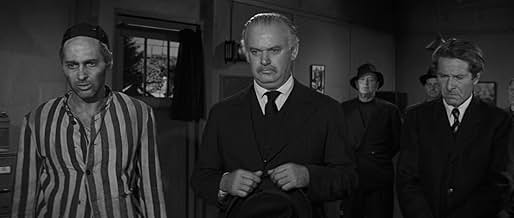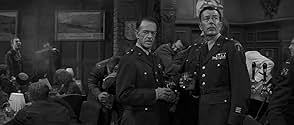NOTE IMDb
7,1/10
9,4 k
MA NOTE
La vie de trois jeunes hommes, un Allemand et deux Américains pendant la 2eme Guerre Mondiale.La vie de trois jeunes hommes, un Allemand et deux Américains pendant la 2eme Guerre Mondiale.La vie de trois jeunes hommes, un Allemand et deux Américains pendant la 2eme Guerre Mondiale.
- Réalisation
- Scénario
- Casting principal
- Nommé pour 3 Oscars
- 1 victoire et 7 nominations au total
John Alderson
- Cpl. Kraus
- (non crédité)
John Banner
- German Town Mayor
- (non crédité)
Stephen Bekassy
- German Major
- (non crédité)
Avis à la une
'The Young Lions,' flaws have prevented my liking it as much as I'd like to.
Mongomery Clift was too old for his role as "young man" Pvt. Noah Ackerman. Clift looks old enough to be the same age as the actor who portrays the father of Ackerman's beloved Hope. Also, the near-repetition of his 'From Here to Eternity' pugilist part feels perverse, excessive, monotonously voyeuristic. Those circumstances aside, Clift's performance finely communicates Ackerman's plaintive, good-hearted tenderness.
Brando's effort is solid, though I'd like to have seen more character development: we know nothing of Christian Diestl's upbringing in Weimar/Nazi Germany except for his revelation that he was a shoemaker's son who ran out of money midway through medical school. More could have been made of the intellect of a young skier whose medical ambitions were, in parallel with the German people's interwar ambitions toward a place in the world befitting their view of themselves, thwarted until their vile demagogue rode the wave of such ambition to utter destruction.
Dean Martin's work is adequate, but not stellar; perhaps a result of his playing the would-be shirker. In some moments his slender dramatic gifts exceed their natural power, but in most of his screen-time he seems to be coasting on his Hollywood persona's legendary charm.
Maximillian Schell's work is first-rate, but it seems to have gotten him typecast in later films as the rabid, or otherwise intrinsically flawed, Nazi officer - which he only managed to again turn into solid effect in 'The Odessa File.' Solid actresses Hope Lange and Barbara Rush aren't given much decent scripting to work with. WWII veteran-writers, the unsurpassable James Jones included, had difficulty portraying women characters: often their female characters seem stilted, if not downright stereotypes. Thus I suspect that 'The Young Lion's' screenwriters hadn't much in the original novel from which to develop its women characters. This also applies to Diestl's girlfriend Francoise (in fact, the most credible female role here is that of Simone who portrays, briefly but heart-rendingly, a woman in dread for her about-to-desert boyfriend Brandt's fate). May Britt, as the opportunistic, adulterous Frau Hardenburg, is adequate; but for her corrupt role the scriptwriters faced no great challenge.
Most preventing my liking this film are its stagey sets and lighting. There's just one superb location scene: the Afrika Korps's dawn ambush of a British unit; the other location scenes - especially of Ackerman's and Whittaker's infantry company - seem much too bucolic in the midst of history's most violent war. The other complaint I have, about this and other post-mid-50's WWII films, is that the women's hairstyles, makeup, and clothing are not of the 1940's, but of the later vogue in which such films were shot: this disjoints the viewer from belief in the period which such films attempt to portray.
'The Young Lions' script leaves much to be desired. It might have been more thoroughly fleshed out, from Irwin Shaw's novel, than it turned out to be. Its best-written scene is of Hope's father taking Noah Ackerman for a contemplative walk round the square of Hope's Vermont hometown, as it flourishes the only writing impressive in economy and power.
One glaring continuity gaffe, in the scene in which Diestl and Brandt meet Simone and Francoise: it's night, yet when Diestl leaves the studio-shot sidewalk table to pursue Francoise to the nearby riverbank, the cut shifts to a location shot made plainly at midday. Quite a few other interior-to-exterior, and vice-versa, scene shifts also detract from the 'The Young Lions' visual flow and credibility. One instance in which it succeeds is actually one in which many other WWII films suffer egregiously: 'The Young Lions' manages to seamlessly weave bits of actual WWII documentary/file footage into its narrative (in one moment, however, this doesn't work: the too-long sequence depicting the El Alamein offensive, which uses documentary clips but which also reuses Hollywood footage from, I think, 'The Desert Rats' or 'The Desert Fox'). This sequence is followed by the almost comical - yet intended to be tragical - motorcycle retreat of Diestl and Hardenburg, which is poorly done in rear-screen projection with the pair astride a bucking, but plainly otherwise stationary, motorcycle (which, by the way, is an American, not a German, bike).
One blooper I caught (but then I'm familiar with such details): after Diestl's African tour he meets Brandt in France, and in the exterior shot Diestl's wearing the old-style Wehrmacht officers cap sans silver chin cords, but when the duo steps into a building to continue conversing, in the interior shot Diestl's cap has magically sprouted the later cap style's chin cords.
An element of unreality in 'The Young Lions' is the remarkable survival rate of Ackerman's infantry squad mates - which doesn't reflect the grievous casualties suffered by U.S. units that fought from D-Day to the final campaign that ended in Germany. (Indeed, ETO commanders howled for replacements for their units' casualties; even the procrustean Patton had reluctantly to accept Negro units as replacements for his decimated formations - though to his credit Patton acknowledged the fitness and combat excellence of those Negro units, about one of which Kareem Abdul Jabbar has well-written a fitting history-cum-tribute).
Though some detail moments of 'The Young Lions' give the story enough meat for the audience to chew and digest satisfyingly, its scopic plot's enormous, world-ranging bones could not have been given enough sinew and muscle to have yielded thoroughgoing excellence, else the film would have run six or more hours. This prompts the expectation that a thoroughly-fleshed mini-series (are you listening HBO?) deserves to be adapted - much more closely and roundly than this 1958 film could have been - from Shaw's novel. In sum the major flaw of 'The Young Lions' is, despite fine acting efforts made on necessarily scant script matter, its failure to have met its ambition of capturing the whole meat of Shaw's story.
Mongomery Clift was too old for his role as "young man" Pvt. Noah Ackerman. Clift looks old enough to be the same age as the actor who portrays the father of Ackerman's beloved Hope. Also, the near-repetition of his 'From Here to Eternity' pugilist part feels perverse, excessive, monotonously voyeuristic. Those circumstances aside, Clift's performance finely communicates Ackerman's plaintive, good-hearted tenderness.
Brando's effort is solid, though I'd like to have seen more character development: we know nothing of Christian Diestl's upbringing in Weimar/Nazi Germany except for his revelation that he was a shoemaker's son who ran out of money midway through medical school. More could have been made of the intellect of a young skier whose medical ambitions were, in parallel with the German people's interwar ambitions toward a place in the world befitting their view of themselves, thwarted until their vile demagogue rode the wave of such ambition to utter destruction.
Dean Martin's work is adequate, but not stellar; perhaps a result of his playing the would-be shirker. In some moments his slender dramatic gifts exceed their natural power, but in most of his screen-time he seems to be coasting on his Hollywood persona's legendary charm.
Maximillian Schell's work is first-rate, but it seems to have gotten him typecast in later films as the rabid, or otherwise intrinsically flawed, Nazi officer - which he only managed to again turn into solid effect in 'The Odessa File.' Solid actresses Hope Lange and Barbara Rush aren't given much decent scripting to work with. WWII veteran-writers, the unsurpassable James Jones included, had difficulty portraying women characters: often their female characters seem stilted, if not downright stereotypes. Thus I suspect that 'The Young Lion's' screenwriters hadn't much in the original novel from which to develop its women characters. This also applies to Diestl's girlfriend Francoise (in fact, the most credible female role here is that of Simone who portrays, briefly but heart-rendingly, a woman in dread for her about-to-desert boyfriend Brandt's fate). May Britt, as the opportunistic, adulterous Frau Hardenburg, is adequate; but for her corrupt role the scriptwriters faced no great challenge.
Most preventing my liking this film are its stagey sets and lighting. There's just one superb location scene: the Afrika Korps's dawn ambush of a British unit; the other location scenes - especially of Ackerman's and Whittaker's infantry company - seem much too bucolic in the midst of history's most violent war. The other complaint I have, about this and other post-mid-50's WWII films, is that the women's hairstyles, makeup, and clothing are not of the 1940's, but of the later vogue in which such films were shot: this disjoints the viewer from belief in the period which such films attempt to portray.
'The Young Lions' script leaves much to be desired. It might have been more thoroughly fleshed out, from Irwin Shaw's novel, than it turned out to be. Its best-written scene is of Hope's father taking Noah Ackerman for a contemplative walk round the square of Hope's Vermont hometown, as it flourishes the only writing impressive in economy and power.
One glaring continuity gaffe, in the scene in which Diestl and Brandt meet Simone and Francoise: it's night, yet when Diestl leaves the studio-shot sidewalk table to pursue Francoise to the nearby riverbank, the cut shifts to a location shot made plainly at midday. Quite a few other interior-to-exterior, and vice-versa, scene shifts also detract from the 'The Young Lions' visual flow and credibility. One instance in which it succeeds is actually one in which many other WWII films suffer egregiously: 'The Young Lions' manages to seamlessly weave bits of actual WWII documentary/file footage into its narrative (in one moment, however, this doesn't work: the too-long sequence depicting the El Alamein offensive, which uses documentary clips but which also reuses Hollywood footage from, I think, 'The Desert Rats' or 'The Desert Fox'). This sequence is followed by the almost comical - yet intended to be tragical - motorcycle retreat of Diestl and Hardenburg, which is poorly done in rear-screen projection with the pair astride a bucking, but plainly otherwise stationary, motorcycle (which, by the way, is an American, not a German, bike).
One blooper I caught (but then I'm familiar with such details): after Diestl's African tour he meets Brandt in France, and in the exterior shot Diestl's wearing the old-style Wehrmacht officers cap sans silver chin cords, but when the duo steps into a building to continue conversing, in the interior shot Diestl's cap has magically sprouted the later cap style's chin cords.
An element of unreality in 'The Young Lions' is the remarkable survival rate of Ackerman's infantry squad mates - which doesn't reflect the grievous casualties suffered by U.S. units that fought from D-Day to the final campaign that ended in Germany. (Indeed, ETO commanders howled for replacements for their units' casualties; even the procrustean Patton had reluctantly to accept Negro units as replacements for his decimated formations - though to his credit Patton acknowledged the fitness and combat excellence of those Negro units, about one of which Kareem Abdul Jabbar has well-written a fitting history-cum-tribute).
Though some detail moments of 'The Young Lions' give the story enough meat for the audience to chew and digest satisfyingly, its scopic plot's enormous, world-ranging bones could not have been given enough sinew and muscle to have yielded thoroughgoing excellence, else the film would have run six or more hours. This prompts the expectation that a thoroughly-fleshed mini-series (are you listening HBO?) deserves to be adapted - much more closely and roundly than this 1958 film could have been - from Shaw's novel. In sum the major flaw of 'The Young Lions' is, despite fine acting efforts made on necessarily scant script matter, its failure to have met its ambition of capturing the whole meat of Shaw's story.
`The Young Lions' is the Second War II presented through the participation of three soldiers. Christian Diestl (Marlon Brando) is an idealistic German, son of a shoemaker. He joins the Army believing that life could improve in Germany under the administration of the Nazis. However, being a soldier, he cannot accept `acting like a police' in an occupied Paris and requests transference to the front, where he has another disappointment with the cruelty of the war. Noah Ackerman (Montgomery Clift) is a shy American Jew, a very simple man, just married with Hope Plowman (Hope Lange) and very discriminated in his platoon for being Jew. He goes to the war and leaves his family. Michael Whiteacre (Dean Martin) is a successful actor who became friend of Noah while in New York and is also obliged to join the army and go to London. There, he decides to leave the office activity and join his platoon in the front. This movie is excellent. It shows common people being used by government in a senseless war. All the main characters are peaceful common persons: Christian is a very simple person, wishing to climb socially in life in a Germany without opportunities and is misguided by the speech of Hitler and pretty soon he becomes aware how stupid war is. Noah is also a very simple person, a salesman from a department store, who indeed wishes to be with his family and join the Army just for obligation. And Michael is a selfish actor and bon vivant, without any sense of patriotism and who is not interest in anything but to have his life back. These characters are put together in a stupid war, having to kill persons to save their lives and to obey orders, which they do not agree. This movie is an excellent perspective of the stupidity of a war. My vote is eight.
Lt. Christian Diestl (Marlon Brando) is a dutiful German who finds the war more and more troubling. Meanwhile back in the US, Jewish Noah Ackerman (Montgomery Clift) finds love, and entertainer Michael Whiteacre (Dean Martin) try to avoid the war.
This movie is split in three. I find the Marlon Brando part very intriguing right from the start. A straight movie with just his character would be very interesting. Brando sets a serious compelling tone. Clift and Martin's movie starts slowly. Quite frankly, it starts as an old fashion melodramatic romance with puppy dog Montgomery Clift. Martin has even less to do as he debates whether to join the fight or not. The movie crawls along at times, and would probably be better served to just keep Brando. Although Clift has some minor drama. At 167 minutes, this is like 2 movies jammed into one. The connection between the stories is tenuous at best until the very end. It seems it took forever to get there. Once there, the point of the movie is made crystal clear, but it seems that it could have been done with a much tighter story.
This movie is split in three. I find the Marlon Brando part very intriguing right from the start. A straight movie with just his character would be very interesting. Brando sets a serious compelling tone. Clift and Martin's movie starts slowly. Quite frankly, it starts as an old fashion melodramatic romance with puppy dog Montgomery Clift. Martin has even less to do as he debates whether to join the fight or not. The movie crawls along at times, and would probably be better served to just keep Brando. Although Clift has some minor drama. At 167 minutes, this is like 2 movies jammed into one. The connection between the stories is tenuous at best until the very end. It seems it took forever to get there. Once there, the point of the movie is made crystal clear, but it seems that it could have been done with a much tighter story.
A long time ago, some time before the powers that be decided that movies should be made only to extricate money from children by catering to their base instincts and in so doing destroy our civility, the American Cinema was devoted to the art and craft of story telling. In these stories, life was often celebrated through the study of the character of the human heart.
In THE YOUNG LIONS, we experience masterful story writing in the screenplay by a man named Edward Anhalt who adapted it from a novel by Irwin Shaw. In this fine example of the final years of the Golden Age of Hollywood we see a study of character, ideas and humanity seen amidst the greatest conflict this Earth has ever known, WWII.
Here, we experience both the Americans and Europeans, including Germans. They are played as they really were, not as depicted by latter day directors such as Steven Spielberg and others who have drawn WWII Germans as silhouette, cartoon characters, all vile and evil. Here, they are shown as singular human beings with personalities, hopes and dreams really exactly like our own. The opposing forces are caught up in a madness that somehow swept across the face of this planet at a specific time, when really probed, for reasons quite unfathomable. This was also one of the peak film renderings of Marlon Brando, whom some feel is one of the finest actors ever to have graced the silver screen.
If you yearn for a fulfilling example of American Cinema at a time when it was a serious, respected industry, this is one for you to see.
In THE YOUNG LIONS, we experience masterful story writing in the screenplay by a man named Edward Anhalt who adapted it from a novel by Irwin Shaw. In this fine example of the final years of the Golden Age of Hollywood we see a study of character, ideas and humanity seen amidst the greatest conflict this Earth has ever known, WWII.
Here, we experience both the Americans and Europeans, including Germans. They are played as they really were, not as depicted by latter day directors such as Steven Spielberg and others who have drawn WWII Germans as silhouette, cartoon characters, all vile and evil. Here, they are shown as singular human beings with personalities, hopes and dreams really exactly like our own. The opposing forces are caught up in a madness that somehow swept across the face of this planet at a specific time, when really probed, for reasons quite unfathomable. This was also one of the peak film renderings of Marlon Brando, whom some feel is one of the finest actors ever to have graced the silver screen.
If you yearn for a fulfilling example of American Cinema at a time when it was a serious, respected industry, this is one for you to see.
An interesting vision of young men in war. The idealist, the shy and the playboy get to war. All will be changed by the horror of the conflict, not only with enemy troops, but within their ranks.
Lt. Christian Diestl's (Marlon Brando) sense of honor and gentle behavior clashes with the cruel, senseless attitude of his superior, Capt. Hardenberg, realistically played by Maximilian Schell.
Private Ackerman (Montgomery Clift) a shy unassuming Jewish boy becomes a courageous soldier, opposing both enemy soldiers and the bigotry of their comrades.
Private Withacre, a playboy who tries to avoid duty (Dean Martin), finally ends up resigning a safe post to join the fighting in Normandy, and becoming a soldier.
The usual Black and White shooting enhances the cruelty of WWII. If you find it, don't miss this performance by great actors.
Lt. Christian Diestl's (Marlon Brando) sense of honor and gentle behavior clashes with the cruel, senseless attitude of his superior, Capt. Hardenberg, realistically played by Maximilian Schell.
Private Ackerman (Montgomery Clift) a shy unassuming Jewish boy becomes a courageous soldier, opposing both enemy soldiers and the bigotry of their comrades.
Private Withacre, a playboy who tries to avoid duty (Dean Martin), finally ends up resigning a safe post to join the fighting in Normandy, and becoming a soldier.
The usual Black and White shooting enhances the cruelty of WWII. If you find it, don't miss this performance by great actors.
Le saviez-vous
- AnecdotesMontgomery Clift was widely felt to look too old and unhealthy to be an A1 soldier. Although Clift was only 36 during filming, this was the first full film he had made since his near-fatal 1956 car accident (it occurred during filming of L'arbre de vie (1957)), which had drastically altered his appearance.
- GaffesEarly in the movie, Marlon Brando's character is riding in some sort of staff car. The car is right-hand drive; the Germans did not use right-hand drive. However, the staff car is a French-made Laffly V15T, which is, indeed, right-hand drive and was used by the French Army in WWII. The vehicle was probably captured from the French Army.
- Citations
Michael Whiteacre: You want me to get shot. Look, I've read all the books. I know that in 10 years we'll be bosom friends with the Germans and the Japanese. Then I'll be pretty annoyed that I was killed.
- ConnexionsFeatured in V.I.P.-Schaukel: Épisode #8.2 (1978)
Meilleurs choix
Connectez-vous pour évaluer et suivre la liste de favoris afin de recevoir des recommandations personnalisées
Détails
- Date de sortie
- Pays d’origine
- Langues
- Aussi connu sous le nom de
- La ira de los dioses
- Lieux de tournage
- Société de production
- Voir plus de crédits d'entreprise sur IMDbPro
Box-office
- Budget
- 3 550 000 $US (estimé)
- Montant brut mondial
- 9 363 $US
- Durée2 heures 47 minutes
- Couleur
- Mixage
- Rapport de forme
- 2.35 : 1
Contribuer à cette page
Suggérer une modification ou ajouter du contenu manquant


